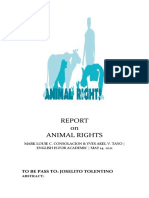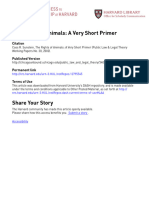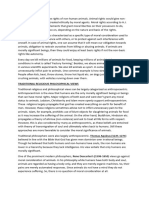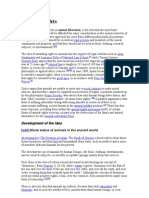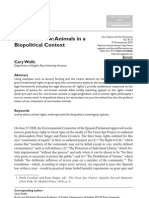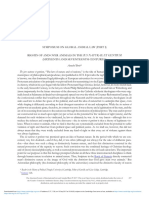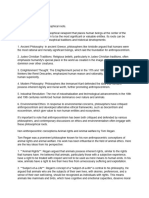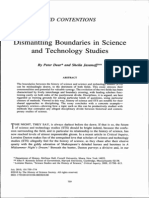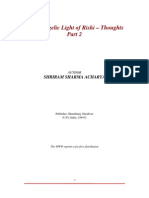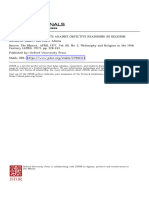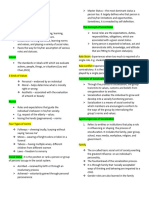Rights of Animals
Rights of Animals
Uploaded by
Khaja Shaikh Sabina CentreCopyright:
Available Formats
Rights of Animals
Rights of Animals
Uploaded by
Khaja Shaikh Sabina CentreCopyright
Available Formats
Share this document
Did you find this document useful?
Is this content inappropriate?
Copyright:
Available Formats
Rights of Animals
Rights of Animals
Uploaded by
Khaja Shaikh Sabina CentreCopyright:
Available Formats
Animal rights, also known as animal liberation, is the idea that the most basic interests of nonhuman animals
should be afforded the same consideration as the similar interests of human beings. Advocates approach the issue from different philosophical positions, ranging from the protectionist side of the movement, presented by philosopher Peter Singerwith a utilitarian focus on suffering and consequences, rather than on the concept of rightsto the abolitionist side, represented by law professor Gary Francione, who argues that animals need only one right: the right not to be property. Despite the different approaches, advocates broadly agree that animals should be viewed as non-human persons and members of the moral community, and should not be used as food, clothing, research subjects, or entertainment.[3] The idea of awarding rights to animals has the support of legal scholars such as Alan Dershowitz and Laurence Tribe of Harvard Law School. Animal rights is routinely covered in universities in philosophy or applied ethics courses, and as of 2011 animal law was taught in 135 law schools in the United States and Canada. Toronto lawyer Clayton Ruby argued in 2008 that the movement had reached the stage the gay rights movement was at 25 years earlier.[4] Critics of the idea argue that animals are unable to enter into a social contract or make moral choices, and for that reason cannot be regarded as possessors of rights, a position summed up by the philosopher Roger Scruton, who wrote in 2000 that only humans have duties and therefore only humans have rights. There has also been criticism, including from within the animal rights movement itself, of certain forms of animal rights activism, in particular the destruction of fur farms and animal laboratories by the Animal Liberation Front. A parallel argument is that there is nothing inherently wrong with using animals as resources so long there is no unnecessary suffering, a view known as the animal welfare position.[5]
Moral status of animals in the ancient world
Michelangelo's The Creation of Adam. The Book of Genesis said God gave humankind "dominion" over non-humans.[6] The 21st-century debates about how humans should treat animals can be traced to the ancient world. The idea that the use of animals by humansfor food, clothing, entertainment, and as research subjectsis morally acceptable, springs mainly from two sources. First, there is the idea of a divine hierarchy based on the theological concept of "dominion," from Genesis (1:20 28), where Adam is given "dominion over the fish of the sea, and over the fowl of the air, and over the cattle, and over all the earth, and over every creeping thing that creepeth upon the earth." Although the concept of dominion need not entail property rights, it has been interpreted over the centuries to imply ownership. There is also the idea that animals are inferior because they lack rationality and language, and as such are worthy of less consideration than humans, or even none.[6] Springing from this is the idea that individual animals have no separate moral identity: a pig is simply an example of the class of pigs, and it is to the class, not to the
individual, that human stewardship should be applied. This leads to the argument that the use of individual animals is acceptable so long as the species is not threatened with extinction.[7 For those who would like to take action but do not know where they stand from a legal point, herewith the Prevention of Animal Cruelty Act. It makes interesting reading! It is a very old act (1960!) but has been many times amended. As you can read, there is actually quite good legal protection against animal cruelty but it does need to get enforced which it often is not. Nonetheless, it is good that these laws are there as it gives those who try to fight/prevent animal cruelty at least legally the right to take steps. I have found that just by showing people this leaflet it makes them think twice before doing/continuing anything nasty to animals. Attached Images
You might also like
- Tom Regan - The Philosophy of Animal Rights PDFDocument17 pagesTom Regan - The Philosophy of Animal Rights PDFDianaNo ratings yet
- Animal Rites: American Culture, the Discourse of Species, and Posthumanist TheoryFrom EverandAnimal Rites: American Culture, the Discourse of Species, and Posthumanist TheoryRating: 4 out of 5 stars4/5 (6)
- A2 AnthropocentrismDocument18 pagesA2 AnthropocentrismJonathan CantuNo ratings yet
- Appiah PostcolonialDocument5 pagesAppiah PostcolonialXiaoda WangNo ratings yet
- The Lucis Trust and Why You Should CareDocument6 pagesThe Lucis Trust and Why You Should Careuser6369850% (4)
- Animal RightDocument3 pagesAnimal RightRandom TvNo ratings yet
- Animal Rights Is The Idea in Which Some, or All,: LphabetDocument1 pageAnimal Rights Is The Idea in Which Some, or All,: LphabetcitizenNo ratings yet
- Animal RightsDocument4 pagesAnimal RightsWan NajmieNo ratings yet
- On Animal Rights: To Be Pass To: Joselito TolentinoDocument7 pagesOn Animal Rights: To Be Pass To: Joselito Tolentinoイヴ・ アケル・ タヨNo ratings yet
- The Rights of Animals - A Very Short PrimerDocument17 pagesThe Rights of Animals - A Very Short Primeraybche90No ratings yet
- The Rights of Animals: A Very Short PrimerDocument15 pagesThe Rights of Animals: A Very Short PrimerajkochanowiczNo ratings yet
- Animal Abuse and Moral Standard of Living ThingsDocument4 pagesAnimal Abuse and Moral Standard of Living ThingsTristan PesaNo ratings yet
- Oderberg - The Illusion of Animal RightsDocument9 pagesOderberg - The Illusion of Animal RightsfrecyclNo ratings yet
- Animal RightsDocument5 pagesAnimal RightsAfif AzharNo ratings yet
- Philosophical Foundations of Animal RightsDocument23 pagesPhilosophical Foundations of Animal RightsnuNo ratings yet
- JPE0048-Korsgaard 3Document33 pagesJPE0048-Korsgaard 3Joshua CloughNo ratings yet
- Group 4 Jurisprudence AssignmentDocument8 pagesGroup 4 Jurisprudence Assignment75q6xvjcgpNo ratings yet
- Animal RightsDocument3 pagesAnimal RightsShiva VislavathNo ratings yet
- Engl1511 Annbib AnimalrightsarticleDocument6 pagesEngl1511 Annbib Animalrightsarticleapi-232646655No ratings yet
- The Rights of Animals: Chicago UnboundDocument17 pagesThe Rights of Animals: Chicago UnboundtravelNo ratings yet
- Animal Rights: Animal Rights, Also Known As Animal Liberation, Is The Idea That The Most BasicDocument27 pagesAnimal Rights: Animal Rights, Also Known As Animal Liberation, Is The Idea That The Most BasicKate20No ratings yet
- The Rights of Animal PersonsDocument45 pagesThe Rights of Animal PersonsABNo ratings yet
- Great Ape Personhood (Justin Fox) PDFDocument34 pagesGreat Ape Personhood (Justin Fox) PDFpranav323No ratings yet
- Before The Law: Animals in A Biopolitical Context: Cary WolfeDocument16 pagesBefore The Law: Animals in A Biopolitical Context: Cary WolfeLA ELNo ratings yet
- Francione Charlton Animal RightsDocument22 pagesFrancione Charlton Animal RightsFlorencia MunnNo ratings yet
- Worksheet - Critical Reading WritingDocument2 pagesWorksheet - Critical Reading Writingapi-321571171No ratings yet
- The Animal Liberation MovementDocument8 pagesThe Animal Liberation Movementngamso100% (1)
- Animal LiberationDocument10 pagesAnimal LiberationAlphonce GeorgeNo ratings yet
- The Claims of Animals and The Needs of StrangersDocument21 pagesThe Claims of Animals and The Needs of StrangersFilosofia FuacNo ratings yet
- Animal Rights DeclarationDocument7 pagesAnimal Rights Declarationsid1214No ratings yet
- Astrid ResearchDocument3 pagesAstrid ResearchKimberly Grace MontemayorNo ratings yet
- Rights of AnimalsDocument17 pagesRights of AnimalsDaria CharmNo ratings yet
- Is There Anything Wrong With SpeciesismDocument4 pagesIs There Anything Wrong With SpeciesismSamuel WinderNo ratings yet
- Political Theory and EcologyDocument14 pagesPolitical Theory and EcologyDHRUV CHOPRANo ratings yet
- Animal Citizen Jurisprudence CopyDocument27 pagesAnimal Citizen Jurisprudence CopyTanima LalNo ratings yet
- Class Notes Jil 203 Human Rights LawDocument23 pagesClass Notes Jil 203 Human Rights Lawnaomiakor0No ratings yet
- Rain Without Thunder: The Ideology of the Animal Rights MovementFrom EverandRain Without Thunder: The Ideology of the Animal Rights MovementRating: 4.5 out of 5 stars4.5/5 (11)
- Animal Rights Animal WrongsDocument4 pagesAnimal Rights Animal Wrongsapi-312881892No ratings yet
- Animal RightsDocument13 pagesAnimal Rights6w5n9bjzzbNo ratings yet
- Animal Liberation Critique-1978Document14 pagesAnimal Liberation Critique-1978shruti8495No ratings yet
- Final EssayDocument8 pagesFinal Essayayşenur günayNo ratings yet
- Animal Rights - Interconnections With Human Rights and The EnvironmentDocument7 pagesAnimal Rights - Interconnections With Human Rights and The EnvironmentAngelisa L. RazoNo ratings yet
- Symposium On Global Animal Law (Part I) : GenesisDocument5 pagesSymposium On Global Animal Law (Part I) : GenesisAaron WuNo ratings yet
- Animal Rights TheoriesDocument22 pagesAnimal Rights Theoriessid1214No ratings yet
- The Moral Staus of Animals by Martha Nussbaum 2006Document7 pagesThe Moral Staus of Animals by Martha Nussbaum 2006Henrique BrumNo ratings yet
- The Rights of AnimasDocument3 pagesThe Rights of AnimasjonygringoNo ratings yet
- Edwin LockeDocument4 pagesEdwin Locke6ynkzmmcfvNo ratings yet
- Pearson ShortDocument18 pagesPearson ShortAlmirante211No ratings yet
- This House Believes That Animal Have Rights (+) Affirmative Team - Animal Rights Is Fundamental Principle About Moral and Legal Right ReasonDocument3 pagesThis House Believes That Animal Have Rights (+) Affirmative Team - Animal Rights Is Fundamental Principle About Moral and Legal Right ReasonRosi ArristaNo ratings yet
- Animal RightsDocument22 pagesAnimal Rightsantra sisodiyaNo ratings yet
- Gary Francione - Abortion and Animal Rights (1995)Document11 pagesGary Francione - Abortion and Animal Rights (1995)Kaniel 0utisNo ratings yet
- Equitable Self-Ownership For Animals Human MonsterDocument30 pagesEquitable Self-Ownership For Animals Human MonsterSue RhoadesNo ratings yet
- Emerging Ethics in Cambridge History ofDocument10 pagesEmerging Ethics in Cambridge History ofucup.sama.us94No ratings yet
- Environmental Philo. SterbaDocument4 pagesEnvironmental Philo. SterbaJanbert Rebosura100% (1)
- Human Rights - Four Schools of ThoughtDocument21 pagesHuman Rights - Four Schools of Thoughtarpita100% (1)
- Right TheoryDocument16 pagesRight Theorygabosara298No ratings yet
- Animal RightsDocument4 pagesAnimal RightsANGELICA FHEB PONo ratings yet
- Localizando Anmales Filo PoliticaDocument10 pagesLocalizando Anmales Filo PoliticaJorge Eliecer Sierra MerchanNo ratings yet
- Animal Rights Without Liberation: Applied Ethics and Human ObligationsFrom EverandAnimal Rights Without Liberation: Applied Ethics and Human ObligationsNo ratings yet
- Singer The Animal Liberation MovementDocument12 pagesSinger The Animal Liberation MovementNina SapphireNo ratings yet
- AnthropocentrismDocument2 pagesAnthropocentrismJamilNo ratings yet
- Narayana Guru'S Concept of Religion: Chapter - IiiDocument74 pagesNarayana Guru'S Concept of Religion: Chapter - IiiManeesh VNo ratings yet
- Philosophy 1st Grading Reviewer PDFDocument13 pagesPhilosophy 1st Grading Reviewer PDFHikari YuukiNo ratings yet
- Dismantling BoundariesDocument17 pagesDismantling BoundariesMiguel ZapataNo ratings yet
- Essay - Ignorant SchoolmasterDocument3 pagesEssay - Ignorant SchoolmasterGabriel FaersteinNo ratings yet
- Desert EssayDocument2 pagesDesert EssayMatt CavaliereNo ratings yet
- Prophet Abammon and The Dialogues of Hermes AddeyDocument3 pagesProphet Abammon and The Dialogues of Hermes AddeynidavanNo ratings yet
- Quantum LeadershipDocument9 pagesQuantum LeadershipDesiree WangNo ratings yet
- Violence of DR Jekyll and MR Hyde: Teacher: Alexander Guerra B.E Literature and EnglishDocument4 pagesViolence of DR Jekyll and MR Hyde: Teacher: Alexander Guerra B.E Literature and EnglishйныNo ratings yet
- BARROSO, Luís Roberto. "Here, There and Everywhere" - Human Dignity in Contemporary Law and in The Transnational DiscourseDocument72 pagesBARROSO, Luís Roberto. "Here, There and Everywhere" - Human Dignity in Contemporary Law and in The Transnational DiscourseVitor VieiraNo ratings yet
- 2676062-Rishi Chintan (English Edition Part 2) - Book of Motivational and Inspirational Quotes, Authored by Acharya Shriram SharmaDocument29 pages2676062-Rishi Chintan (English Edition Part 2) - Book of Motivational and Inspirational Quotes, Authored by Acharya Shriram SharmaGuiding Thoughts- Books by Pandit Shriram Sharma Acharya100% (1)
- Tenets of CDADocument13 pagesTenets of CDAVan AnhNo ratings yet
- (Jin Zhilin) Chinese Folk ARTSDocument145 pages(Jin Zhilin) Chinese Folk ARTSLatonya Hansen100% (7)
- Integrity in Management ConsultingDocument7 pagesIntegrity in Management ConsultingDyah Palupi HapsariNo ratings yet
- Are Induction and Well-Ordering EquivalentDocument8 pagesAre Induction and Well-Ordering EquivalentBleeding Heart RaverNo ratings yet
- This Content Downloaded From 185.192.71.174 On Wed, 29 Mar 2023 20:32:06 UTCDocument17 pagesThis Content Downloaded From 185.192.71.174 On Wed, 29 Mar 2023 20:32:06 UTCBeniamimus BarnettusNo ratings yet
- Tourism and Invention. Roland Barthes's Empire of Signs, by Craig Jonathan SaperDocument235 pagesTourism and Invention. Roland Barthes's Empire of Signs, by Craig Jonathan SaperDavid FielNo ratings yet
- Jainism and BuddhismDocument5 pagesJainism and BuddhismSameer NameNo ratings yet
- Great Quotes From Great LeadersDocument8 pagesGreat Quotes From Great LeadersVVRAO90No ratings yet
- Cotterrell-Notes On Future of The Sociology of LawDocument19 pagesCotterrell-Notes On Future of The Sociology of LawEduardo Cesar Castillo ClaudettNo ratings yet
- RIZA Philosophers TimelineDocument2 pagesRIZA Philosophers TimelineMisha Madeleine GacadNo ratings yet
- Heraclitus Vs ParmenidesDocument4 pagesHeraclitus Vs ParmenidesGregory Everette HuffmanNo ratings yet
- You Are Not WolinskiDocument336 pagesYou Are Not Wolinskiawreeve100% (13)
- GEC 7: General Ethics 1. Title of The ModuleDocument8 pagesGEC 7: General Ethics 1. Title of The ModuleAntonette GeguintoNo ratings yet
- How Perceptions Shape Realities (Issue 97)Document16 pagesHow Perceptions Shape Realities (Issue 97)Serghei CebotariNo ratings yet
- Truth and Immortality in Augustine's de Immortalitate AnimaeDocument24 pagesTruth and Immortality in Augustine's de Immortalitate AnimaeSalvador Latorre PeñaNo ratings yet
- Part 1, IntroductionDocument12 pagesPart 1, IntroductionSandra ManuelsdóttirNo ratings yet
- Harambee University Post Graduate Program Masters of Business Administration (MBA)Document3 pagesHarambee University Post Graduate Program Masters of Business Administration (MBA)Anteneh tesfayeNo ratings yet
- Ucsp Unit Iii ReviewerDocument7 pagesUcsp Unit Iii Reviewerslsuls.sheekainasalvaniaNo ratings yet








